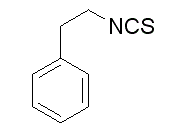The training set of documents was manually annotated for numeric values and dendrimer property terms using GATE. Following the annotation, the numeric values associated with each property term were extracted manually and organized in a tabular format for ease of use and comparison. Once the pipeline was able to successfully annotate the numeric values and the dendrimer property terms, we developed an algorithm that would associate numeric values and dendrimer property terms that occurred within the same sentence using proximity metrics. We selected a proximity distance metric of 200 characters because our preliminary experiments have shown that the sensitivity and specificity of the system was best for this distance in the training set. For instance we observed that if we increased it, the number of false positives increased without any improvement in the observed recall of the system. Finally, we optimized performance iteratively before moving on to the test set of documents. Upon achieving an inter-rater reliability of 80%, the annotators independently reviewed, annotated, and extracted information from the test set of articles. Again, the numeric values and dendrimer property terms were taken from the NPO and were annotated using GATE. Following the annotation, the numeric values associated with each property term were extracted and organized in a tabular format. These results indicate that the NanoSifter NLP system can, generally, extract numeric values  associated with particle property terms from dendrimers reported in the cancer treatment literature with high recall, precision, and f-measure scores. To the authors’ knowledge, these results are the first application of text mining to extract numeric values associated to dendrimer property terms from nanomedicine literature. With regards to our application, the high recall values are more important than the moderate precision values. This is because the lack of precision is manageable and can be quickly corrected by manual post processing of the annotated text. NanoSifter uses a method that appears to be generally reliable and accurate. However, there are imperfections that were observed while processing and analyzing the data from this study. First, the data extracted by our method is not always directly associated with a dendrimer nanoparticle. For instance, many times the system correctly finds, annotates, and extracts a “molecular weight measurement”, but this measurement may be associated with a subunit utilized in the synthesis of a PAMAM dendrimer or another Procyanidin-B1 material used in one of the articles. A method to address this limitation could include post-analysis manual review of the system’s performance. Another limitation of our system is that the NanoSifter algorithm can only pair a nanoparticle property term with a single numeric value annotation before and after itself. This causes a problem when a sentence is more complex and contains a property term, random text, numeric value, random text, or another numeric value. In NLP, this is a problem called co-reference resolution, and it could be 10-Gingerol addressed with a more sophisticated language model than the one used in this study. The results from our analysis demonstrate that the NanoSifter NLP system can be used to reliably and accurately extract information from dendrimers developed for cancer treatment literature and shows promise for the future of text mining in the field of nanoinformatics. This initial research in the field of applying NLP to nanomedicine literature could assist in significant advances for the nanomedicine community.
associated with particle property terms from dendrimers reported in the cancer treatment literature with high recall, precision, and f-measure scores. To the authors’ knowledge, these results are the first application of text mining to extract numeric values associated to dendrimer property terms from nanomedicine literature. With regards to our application, the high recall values are more important than the moderate precision values. This is because the lack of precision is manageable and can be quickly corrected by manual post processing of the annotated text. NanoSifter uses a method that appears to be generally reliable and accurate. However, there are imperfections that were observed while processing and analyzing the data from this study. First, the data extracted by our method is not always directly associated with a dendrimer nanoparticle. For instance, many times the system correctly finds, annotates, and extracts a “molecular weight measurement”, but this measurement may be associated with a subunit utilized in the synthesis of a PAMAM dendrimer or another Procyanidin-B1 material used in one of the articles. A method to address this limitation could include post-analysis manual review of the system’s performance. Another limitation of our system is that the NanoSifter algorithm can only pair a nanoparticle property term with a single numeric value annotation before and after itself. This causes a problem when a sentence is more complex and contains a property term, random text, numeric value, random text, or another numeric value. In NLP, this is a problem called co-reference resolution, and it could be 10-Gingerol addressed with a more sophisticated language model than the one used in this study. The results from our analysis demonstrate that the NanoSifter NLP system can be used to reliably and accurately extract information from dendrimers developed for cancer treatment literature and shows promise for the future of text mining in the field of nanoinformatics. This initial research in the field of applying NLP to nanomedicine literature could assist in significant advances for the nanomedicine community.